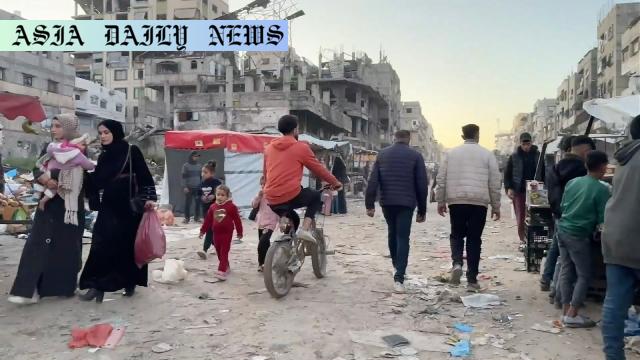Ceasefire: Israel and Hamas face continued disagreements over moving to the second phase of the Gaza ceasefire deal.
Israel and Hamas disagree on the Gaza ceasefire’s second phase.
Israel seeks a longer truce; Hamas demands immediate military withdrawal.
A League of Arab States summit will address Gaza rebuilding plans.

Background of the Ceasefire Agreement
On Saturday, the first phase of the six-week-long ceasefire agreement between Israel and Hamas reached its conclusion. This ceasefire was seen as a pivotal step in fostering hope for peace in the Gaza Strip, a region marred by conflict for decades. However, as negotiations inflamed debates over the transition to the second phase, the fragile peace’s future remains unclear. The second phase of this plan includes Israel’s full military withdrawal from Gaza, a move Hamas resolutely demands. While the agreement originally aimed to pave the way for long-term stability, these intricate discussions signal that achieving true resolution is more complex than anticipated.
Points of Contention: Withdrawal Versus Stability
The primary disagreement lies in the timeline and conditions under which Israel will withdraw its military forces. Hamas argues for an immediate transition to this phase, portraying it as vital to restoring autonomy to Gaza’s residents. On the other hand, Israel raises legitimate fears that such an action could lead to Hamas rearming, further escalating threats in the region. Highlighting the plight of hostages, Israel seeks an extension of the ceasefire to secure additional releases, balancing humanitarian considerations against strategic concerns.
Role of Diplomacy in Breaking Deadlock
Amidst this impasse, international mediators have stepped in to negotiate terms for the deal’s continuity. Key figures such as Egyptian Foreign Minister Badr Abdelatty have worked alongside Palestinian Prime Minister Mohammad Mustafa, advocating for sustainable solutions. Egypt has proposed rebuilding strategies for Gaza designed to avoid displacing Palestinians, further emphasizing regional unity’s importance. Meanwhile, the Arab League summit scheduled for Tuesday provides another opportunity to discuss actionable steps toward improved humanitarian conditions in Gaza.
Broader Implications on Global and Regional Politics
Compounding this already tense situation are global geopolitical ramifications. U.S. President Trump’s controversial suggestion that the United States could take control over Gaza and relocate its citizens has sparked outrage and confusion. This bold proposal raises ethical and political debates about sovereignty and the international community’s role in post-conflict zones. Meanwhile, a growing chorus within Israeli circles advocates resuming military operations, underscoring internal divisions over the value and risks of prolonged peacekeeping efforts. These developments call attention to the delicate balancing act negotiators face in navigating domestic and international expectations.
Path to Rebuilding Gaza: Challenges and Future Prospects
The discussion of Gaza’s reconstruction is viewed as a linchpin in securing long-term peace. Efforts to rebuild infrastructure without uprooting communities aim to instill hope and stability in an otherwise volatile region. However, this ambitious goal is riddled with obstacles, including funding shortages, political resistance, and deep-seated mistrust among stakeholders. By addressing these challenges with coordinated international cooperation and localized initiatives, meaningful progress can be envisioned. This endeavor highlights the necessity of broad-based support, leveraging both financial resources and diplomatic goodwill to foster enduring change for Gaza’s populace.



Commentary
The Need for Empathy Amid Conflict
The ongoing ceasefire negotiations between Israel and Hamas highlight the difficult road ahead for restoring peace in Gaza. At the core of this debate lies a dire need for empathy, understanding, and a commitment to prioritizing human lives over political victories. The region’s people have endured decades of suffering, and every decision made now will have lasting consequences for their future. When stakeholders place humanitarian considerations at the forefront, peace need not remain a distant hope.
Balancing Security and Sovereignty
Israel’s reluctance toward immediate withdrawal is rooted in legitimate fears surrounding Hamas’s rearmament. However, such concerns should not necessarily impede Gaza’s path toward regaining its sovereignty. Finding middle ground that satisfies both security imperatives and the aspirations of Gaza’s people will require transparent dialogue and innovative solutions. International partners must support this process, bridging divides while respecting the unique perspectives of each side.
A Global Responsibility for Peace
The involvement of international actors, whether as mediators or donors for Gaza’s reconstruction, underscores the universal responsibility in ending the cycle of violence in the region. Constructive participation, devoid of exploitative motives, will be critical in fostering communal trust and enabling sustainable progress. As discussions ramp up toward redefining Gaza’s fate, the international community must reject superficial interventions, instead channeling resources and rigorous planning to achieve meaningful outcomes. Because in the end, peace in Gaza is not merely a regional victory – it is a triumph for humanity.